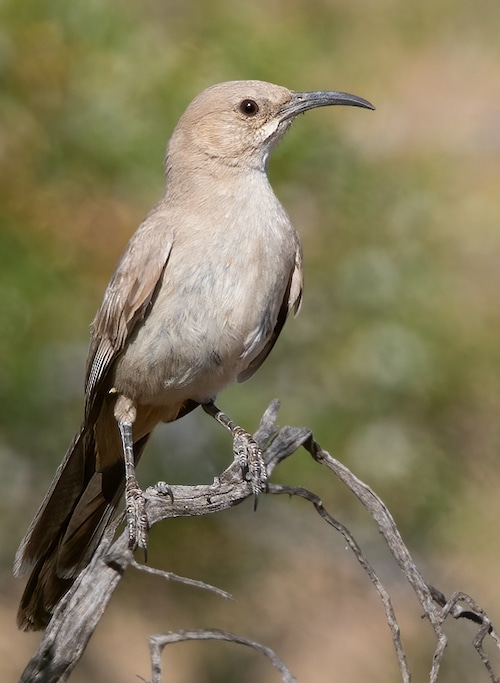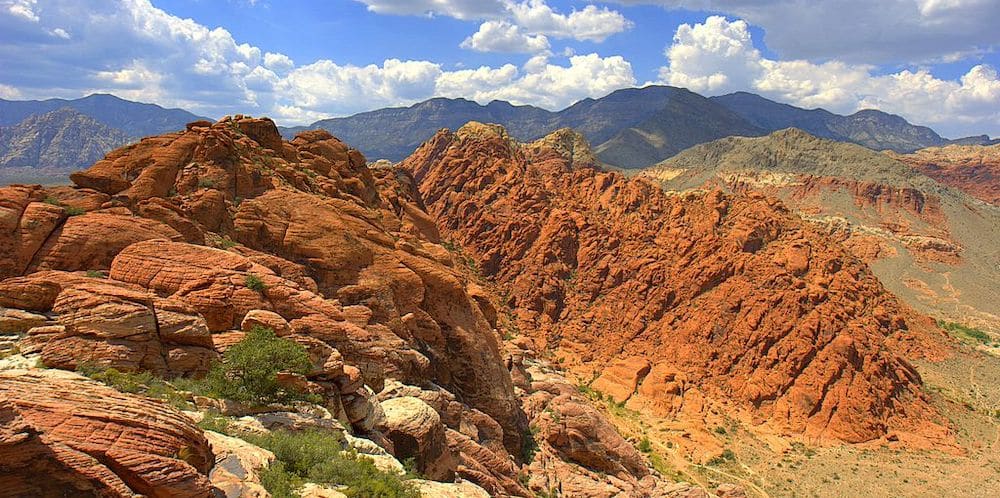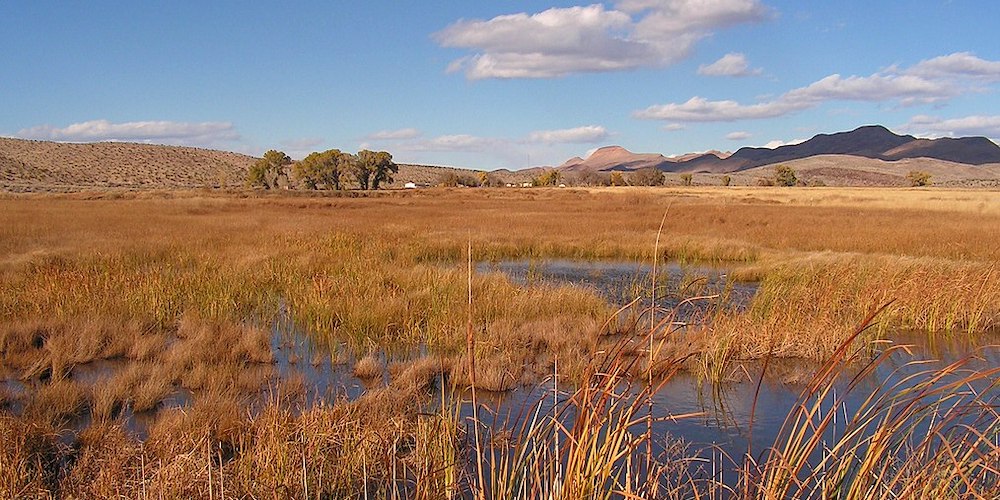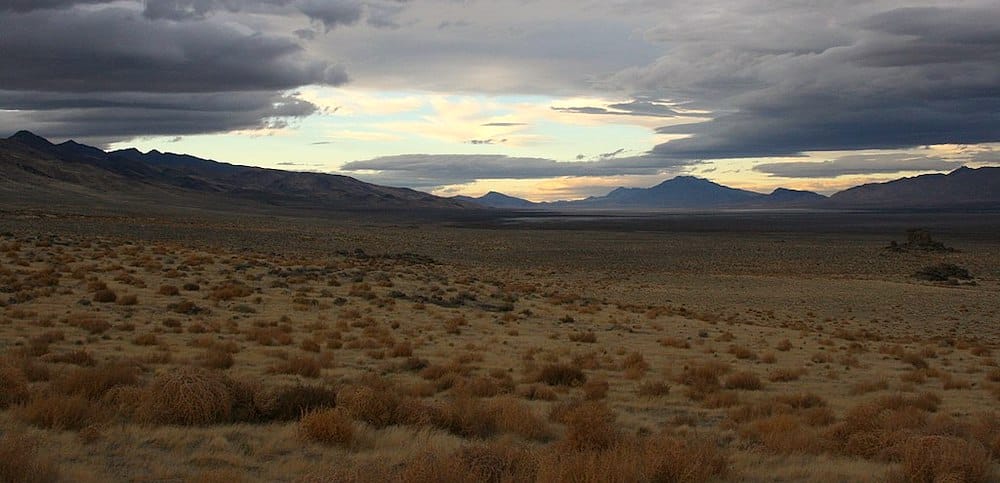State of Nevada

Nevada is a landlocked state in the Western region of the United States. It borders Oregon to the northwest, Idaho to the northeast, California to the west, Arizona to the southeast, and Utah to the east. Nevada is the seventh-most extensive, covering over 286,000 km2 (over 110,000 square miles), the 32nd-most populous, and the ninth-least densely populated of the US states. Nearly three-quarters of Nevada’s people live in Clark County, which contains the Las Vegas-Paradise metropolitan area, including three of the state’s four largest incorporated cities. Nevada’s capital is Carson City. But Las Vegas is by far the largest city in the state with over 650,00 people and the metropolitan area as a whole has a population approaching three million which is most of the state’s population. Reno is the second city with well over half a million inhabitants. Nevada is officially known as the ‘Silver State’ because of the importance of silver to its history and economy.
Nevada is almost entirely within the Basin and Range Province and is broken up by many north–south mountain ranges. Most of these ranges have endorheic valleys between them. Much of the northern part of the state is within the Great Basin, a mild desert that experiences hot temperatures in the summer and cold temperatures in the winter. Occasionally, moisture from the Arizona Monsoon will cause summer thunderstorms; Pacific storms may blanket the area with snow. The state’s highest recorded temperature was 52 °C. The coldest recorded temperature was -47 °C in the northeastern portion of the state.
The Humboldt River crosses the state from east to west across the northern part of the state, draining into the Humboldt Sink near Lovelock. Several rivers drain from the Sierra Nevada eastward, including the Walker, Truckee, and Carson rivers. All of these rivers are endorheic basins, ending in Walker Lake, Pyramid Lake, and the Carson Sink, respectively. However, not all of Nevada is within the Great Basin. Tributaries of the Snake River drain the far north, while the Colorado River, which also forms much of the boundary with Arizona, drains much of southern Nevada. The mountain ranges, some of which have peaks above 13,000 feet, harbour lush forests high above desert plains, creating sky islands for endemic species. The valleys are often no lower in elevation than 3,000 feet, and some, in central Nevada, are above 6,000 feet!.

Calico Basin in Red Rock National Conservation Area near Las Vegas – ©Fred Morledge CC BY-SA 2.5 via Wikimedia Commons
The southern third of the state, where the Las Vegas area is situated, is within the Mojave Desert. The area receives less rain in the winter, but is closer to the Arizona Monsoon in the summer. The terrain is also lower, mostly below 4,000 feet, creating conditions for hot summer days and cool to chilly winter nights. Nevada and California have by far the longest diagonal line (in respect to the cardinal directions) as a state boundary at just over 640 kilometres (400 miles). This line begins in Lake Tahoe and continues to the Colorado River where the Nevada, California, and Arizona boundaries merge southwest of the Laughlin Bridge. The largest mountain range in the southern portion of the state is the Spring Mountain Range, just west of Las Vegas. The state’s lowest point is along the Colorado River, south of Laughlin. Nevada has 172 mountain summits with 2,000 feet of prominence. Nevada ranks second, after Alaska, for the greatest number of mountains in the United States.
It is the driest state in the United States being mostly made up of desert and semi-arid climate regions. With the exception of the Las Vegas Valley, the average summer diurnal temperature range approaches 22 °C in much of the state. While winters in northern Nevada are long and fairly cold, the winter season in the southern part of the state tends to be of short duration and mild. Most parts of Nevada receive scarce precipitation during the year. The most rain falls on the east and northeast slopes of the Sierra Nevada. The average annual rainfall is about 7 inches; the wettest parts get around 40 inches. The vegetation of Nevada is diverse and differs by area. It has six biotic zones: alpine, sub-alpine, ponderosa pine, pinion-juniper, sagebrush and creosote-bush.

The Middle Marsh on the Pahranagat NWR – US Fish and Wildlife Service, Public domain, via Wikimedia Commons
There are 68 designated wilderness areas in Nevada, protecting over 2,662,000 ha) under the jurisdiction of the National Park Service, US Forest Service and the Bureau of Land Management. Protected areas managed by the state include state parks, state historic sites, and state recreation areas. There are 24 state park units, including Van Sickle Bi-State Park which is operated in partnership with the state of California.
Birding Nevada
Most people’s mental image of Nevada is of great expanses of dry desert landscape, covered with sagebrush and blowing sand. The fact that Nevada is the driest state supports this image. In fact, ranked sixth in the nation for biodiversity, and Nevada, a Spanish word meaning snow-covered mountains, it offers birders much more than barren wastelands.
Located almost entirely in the Great Basin portion of the Intermountain Region, Nevada boasts 51 peaks with an elevation over 9,000 feet. This wide range supports many diverse habitats. Nevada is a state of basins and ranges, with numerous north/south lying mountain ranges separated by valleys.
The bird life is as diverse as the habitats, with a state list of just over 500 species, nearly 250 of which are known to breed in the state. Located on the Pacific Flyway, Nevada hosts a wide range of shorebirds and waterfowl. In 1999, over 60,000 shorebirds were tallied in both the Spring and Fall counts, with Long-billed Dowitchers, Black-necked Stilts, and American Avocets as the most numerous species. Large concentrations of wintering raptors can be found in the Northwestern part of the state. Eastern Nevada is the only place in North America to see the introduced Himalayan Snowcock, and southern Nevada receives many visitors for Le Conte’s Thrasher and other desert species.

Valley near Pyramid Lake – ©GIANTPAPAYA CC BY-SA 4.0 via Wikimedia Commons
The state has two Audubon chapters, Lahonton Audubon in the Reno area and Red Rock in Las Vegas, the Great Basin Bird Observatory, and an active Nature Conservancy chapter. An Important Bird Area program has designated several Globally and Continentally Important sites. These include the Goshute Mountains, Lahonton Valley Wetlands, Ruby Lake NWR, and Walker Lake. Pahranagat NWR is a Continentally Important site. Other god bird areas include Franklin Lake, Humboldt WMA and Pyramid Lake. Nevada is also an active member in Partners in Flight.
-
Number of bird species: 508
(As at November 2024)State Bird: Mountain Bluebird Sialia currucoides
-
Avibase
PDF ChecklistThis checklist includes all bird species found in Nevada , based on the best information available at this time. It is based on a wide variety of sources that I collated over many years. I am pleased to offer these checklists as a service to birdwatchers. If you find any error, please do not hesitate to report them. -
Nevada Bird Records Committee
WebpageNevada Bird Records Committee Review List -
Nevada State Parks
PDF ChecklistCHECKLIST OF BIRDS: Spring Mountain Ranch -
Wikipedia
Annotated ListThis list of birds of Nevada includes species documented in the U.S. state of Nevada and accepted by the Nevada Bird Records Committee (NBRC). As of March 2021, there are 491 species and two species pairs included in the official list.[1] Of them, 108 are on the review list (see below) and six have been introduced to North America. Additional accidental species have been added from different sources. -
eBird
PDF ChecklistThis checklist is generated with data from eBird (ebird.org), a global database of bird sightings from birders like you. If you enjoy this checklist, please consider contributing your sightings to eBird. It is 100% free to take part, and your observations will help support birders, researchers, and conservationists worldwide.
-
Atlas of the Breeding Birds of Nevada
| By Ted Floyd | University of Nevada Press | 2007 | Hardback | 581 pages, distribution maps, drawings | ISBN: 9780874176957 Buy this book from NHBS.com -
Birds of the Southwest : Arizona, New Mexico, Southern California, and Southern Nevada
| By John H Rappole | Texas A&M University Press | 2001 | Paperback | 329 pages, 456 col, 44 b/w photos, 1 line drawing, 457 maps | ISBN: 9780890969588 Buy this book from NHBS.com -
Important Bird Areas of Nevada
| By DE McIvor | Lahontan Audubon Society | 2005 | Paperback | 0970343825 | 150 pages, 50+ colour photos, 39 b/w maps, tables | ISBN: 9780970343826 Buy this book from NHBS.com -
Nevada Birding Map
| By Lahontan Audubon Society & Ronald J Conkey | Lahontan Audubon Society | 2007 | Map | colour photos, colour map, dimensions: 61 x 91 cm / 24 x 36 inch | ISBN: 9780970343833 Buy this book from NHBS.com -
Nevada Birds: A Folding Pocket Guide to Familiar Species
| By James R Kavanagh & Raymond Leung | Waterford Press | 2000 | Unbound | 12 pages, colour illustrations | ISBN: 9781583551561 Buy this book from NHBS.com -
https://www.birdlasvegas.com
| By Graham Chisholm & Larry A Neel | University of Nevada Press | 2001 | Paperback | 224 pages, 60 illustrations, 4 maps | ISBN: 9780874174793 Buy this book from NHBS.com
-
Spring Wings Bird Festival
Bird Festival...As many as 250,000 shorebirds have been recorded annually at the site, with peak numbers during spring and fall migration...
-
Great Basin Bird Observatory
Observatory WebsiteSatellite ViewThe Great Basin Bird Observatory is a non-profit organization of scientists dedicated to furthering bird conservation in the Great Basin and adjoining regions.
-
Barrick Museum Las Vegas
WebsiteThe Mission of The Las Vegas Natural History Museum. To inspire, through educational exhibits and programs, a better understanding and appreciation of the natural world, the sciences, and ourselves.
-
Audubon Society in Nevada
WebsiteOffices & Chapters -
Birding Nevada
Facebook PageDiscussion etc -
Bristlecone Audubon
Facebook PageBristlecone Audubon is dedicated to preserving all wild lands, wild watersheds and their wildlife habitats on public and private lands in northeast Nevada, protecting them from ongoing threats, educating the public about the value and need for healthy living landscapes, promoting a conservation ethic in our communities and improving the management and restoration of all native landscapes for the benefit of humanity and earth’s biological diversity. -
Lahontan Audubon Society
WebsiteLahontan Audubon Society (LAS) was founded in December 1963 by Fred Ryser, John Davis, and Marge Sill. LAS started the Truckee Meadows Christmas Bird Count that same year, and has collected over 50 years of data for that original count circle, as well as creating several other area Christmas Bird Count circles. -
Nature Conservancy in Nevada
WebpageWe’re tackling the biggest threats to land and water across Nevada so people and nature can thrive. -
Nevada Bird Records Committee
WebpageIf you have observed a rare bird in Nevada, a written description is an excellent way of providing a credible and permanent record of your observation. The purpose of the Nevada Bird Records Committee (NBRC) is to archive all records of Nevada Review Species, for the long-term objective of determining patterns of occurrence and distribution of Nevada's avifauna. NBRC requests documentation for all observations of species on the Nevada Review List… -
Nevada Wildlife Federation
WebsiteThe Nevada Wildlife Federation (NvWF) is the oldest statewide conservation organization dedicated to sustaining Nevada’s natural resources for wildlife through conservation, preservation, and education. -
Red Rock Audubon Society
WebsiteAs a local Audubon organization, we are dedicated to the conservation of habitat for birds and other wildlife across southern Nevada.
-
*Protected areas of Nevada
InformationSatellite ViewThis category includes articles on protected areas within the U.S. state of Nevada. This includes federal, state, local and privately controlled/owned areas. -
BS Henderson Bird Viewing Preserve
WebpageSatellite ViewThe preserve is located at 350 E. Galleria Dr., near the intersection of Galleria Drive and Boulder Highway (look for signs in the medians). It is located within the Water Reclamation Facility and sits on approximately 140 acres. It is home to thousands of migratory waterfowl as well as numerous resident desert birds. There are nine ponds available for birding, surrounded by both paved and soft surfaces. The paved path is approximately 3/4 of a mile long and is accessible by wheelchair. The soft surfaces are mostly level and allow for easy walking. When you visit, expect to do a lot of walking and allow yourself adequate time to visit the area. We also recommend that you wear appropriate clothing and comfortable, sturdy shoes. Bring water, a hat, and wear sunscreen. If you do not have binoculars, we have some available for loan. -
IBA Bilk Creek - Montana Mountains
InformationSatellite ViewThis large landscape on the Oregon border is centered around one of the highest density Greater Sage-Grouse populations in the country. As part of an extensive landscape area, the site contains numerous habitat types, but is primarily sagebrush and sagebrush-steppe. The Bilk Creek and Montana Mountains are the two prominent ranges within the boundary. -
IBA Swan Lake Nature Study Area
InformationSatellite Viewhe Swan Lake Nature Study Area consists of over 1,800 acres (7 km2) of land, with water supplied by the nearby Reno/Stead Sewage Treatment Plant. The size of the actual wetland varies seasonally and yearly, depending on the amount of precipitation, between 100 and 1,000 acres (4 km2). he Lahontan Audubon Society describes it as "a nearly unspoiled wetland in the midst of suburban housing and warehouses" and designates it a Nevada Important Bird Area. It is a notable location for birding; over 150 species have been observed there. -
NR Las Vegas Springs Preserve
WebsiteSatellite ViewThe Springs Preserve is a hotspot for native wildlife. In addition to the live animal exhibits, we're also home to more than 250 species of native wildlife living in natural and restored habitats along our trails and pathways. As you explore the Springs Preserve, you’re likely to spot free roaming ground squirrels, lizards, insects and more! -
NWR Anaho Island
InformationSatellite ViewThe Anaho Island National Wildlife Refuge is a wildlife refuge on Anaho Island in Pyramid Lake, Nevada.[1] The refuge was established by President Woodrow Wilson in 1913 as a sanctuary for colonial nesting birds. It is home to one of the two largest colonies of pelicans—American white pelicans—in the western U.S. Other birds found on the island include California gulls, Caspian terns, double-crested cormorants, great blue herons, black-crowned night herons, and snowy egrets. -
NWR Ash Meadows
WebpageSatellite ViewAsh Meadows National Wildlife Refuge is a biodiversity hot spot and a haven for rare plants and animals; an incredible story of survival for an ancient species of fish. It is the last remaining oasis in the Mojave Desert, and location of the famous Devils Hole. Stroll along beautiful boardwalks and walk in the footsteps of ancient peoples and pioneers. -
NWR Desert National Wildlife Range
InformationSatellite ViewGolden eagles soaring overhead, rays of sunlight hitting rock shelters carved by time, bristlecone pines twisting toward the sky - these are just a sampling of what Desert National Wildlife Refuge (NWR) offers. -
NWR Fallon
WebpageSatellite ViewFallon National Wildlife Refuge was established by a Congressional Act in 1931 to "...provide a sanctuary and breeding ground for birds and other wildlife". -
NWR Moapa Valley
InformationSatellite ViewThe Moapa Valley National Wildlife Refuge (MVNWR) is a protected wildlife refuge administered by the U.S. Fish and Wildlife Service, located in the Warm Springs Natural Area in the Moapa Valley of Clark County, Nevada. The refuge is east of Death Valley and 60 miles (97 km) northeast of Las Vegas, Nevada. -
NWR Pahranagat
WebpageSatellite ViewFew landscapes are as contrasting as Pahranagat National Wildlife Refuge’s (NWR) lush wetlands and the surrounding Mojave Desert. Nourished by life-giving waters of Crystal and Ash Springs, Pahranagat National Wildlife Refuge offers wetland and riparian habitats for thousands of migratory birds, numerous birds of prey, deer, reptiles, small mammals, and rare fish. -
NWR Ruby Lake
WebpageSatellite ViewOf special interest are the canvasback and redhead nesting areas in the prolific bulrush of the South Marsh, a natural depression at the south end of the refuge. This area has the highest canvasback nesting density of anywhere in North America. During the years of flood and drought extremes, breeding birds were forced to nest elsewhere and managers were concerned about their success with limited wetlands… -
NWR Sheldon
WebpageSatellite ViewThe Refuge’s desert sagebrush-steppe ecosystem in Washoe and Humboldt Counties, Nevada and Lake County, Oregon. The Refuge was established in 1931 to: (1) provide habitat for pronghorn antelope, the primary species, and populations of native secondary species (e.g., mule deer, sage-grouse, and song birds) in such numbers as may be necessary to maintain a balanced wildlife population; (2) conserve listed endangered or threatened fish, wildlife, and plants; and (3) use as an inviolate migratory bird sanctuary. -
NWR Stillwater
WebpageSatellite ViewThe Stillwater marshes were drying up. Home for thousands of years to thousands of migrating birds and northern Paiute Indians who were closely connected to rhythms of the local ecology, the marshes waters were being diverted by twentieth century agriculture, drying them out and threatening wetland life. This is an absorbing story of a group of conservationists ingenious solution - to have the refuge buy agricultural water rights… -
Nevada National Wildlife Refuges
InformationSatellite ViewClick-thru to individual pages… -
WMA Humboldt
InformationSatellite ViewThe Humboldt Wildlife Management Area (WMA) is a wildlife management area in the U.S. state of Nevada, encompassing the salt marshes at the terminus of the Humboldt River. Although resident populations of fish and other wildlife rise and fall according to the level of flow into the Humboldt WMA, the wetlands provide a valuable stopover for migratory and breeding bird populations. Ducks, such as mallards, Canada geese, and American coots are common, as are shorebirds such as the American avocet and raptors such as owls and hawks.
-
eBirds Nevada Rare Bird Alert
SightingsThe report below shows observations of rare birds in Nevada. Includes both unreviewed and reviewed/approved observations. -
nvbirds
Mailing Listdiscussion about Nevada`s bird life
-
Naturalist Journeys
Tour OperatorThis Great Basin birding and nature tour visits Nevada and Utah to explore the most biodiverse parts of the fascinating Great Basin, the United States largest desert. -
The Wild Sights
Tours & GuidingWhether you’re a new birder, worldwide lister or an avid photographer, we can create a custom birding/wildlife experience to meet your desired outcomes...
-
2018 [05 May] - Dermot Hughes & Colin Reid - Southern California, Arizona and a small bit of Nevada
PDF ReportTwo birders, Dermot (Mr H) from Belfast, Northern Ireland and myself from Brisbane, Queensland, Australia. We had planned this trip for last year, but, due to an unforeseen accident, had had to put it off for twelve months. We’re both 63 and been friends for 50 years and have birded together on and off during that time. Mr H has a background in conservation and eco-consultation. I’m just a birder... -
2020 [01 January] - Jeff Hopkins - Desert Southwest
PDF ReportThere were two targets that would have been completely new to me: California Condor and Sagebrush Sparrow. The former had only recently been declared countable by the ABA and could be seen on a quick overnight jaunt from Vegas. The latter was the result of a recent split of Sage Sparrow into Bell’s Sparrow - which I’d previously seen in California - and Sagebrush Sparrow which I never seen. In addition, there were a couple Mexican vagrants that I’d previously only seen in Latin America, that could be possible as new birds for me in the ABA region. -
2024 [08 August] - Bryan Shirley
PDF Report...Fall migration trip to Utah and Nevada. We started in Salt Lake City and birded several wetland areas including Bear River Migratory Bird Refuge and Antelope Island State Park. Shorebird...
-
Yerington Inn
AccommodationNevada's state-owned Wildlife Management Areas (WMAs) are home to many resident and migratory birds and mammals. Found throughout the state, the public can generally drive to a WMA in less than two hours from the major population centers and find great access to wildlife viewing...
-
Area Birding Guide
WebpageA team of dedicated Audubon birders have researched some of northern Nevada’s best bird watching hotspots and written these guides for your use.


